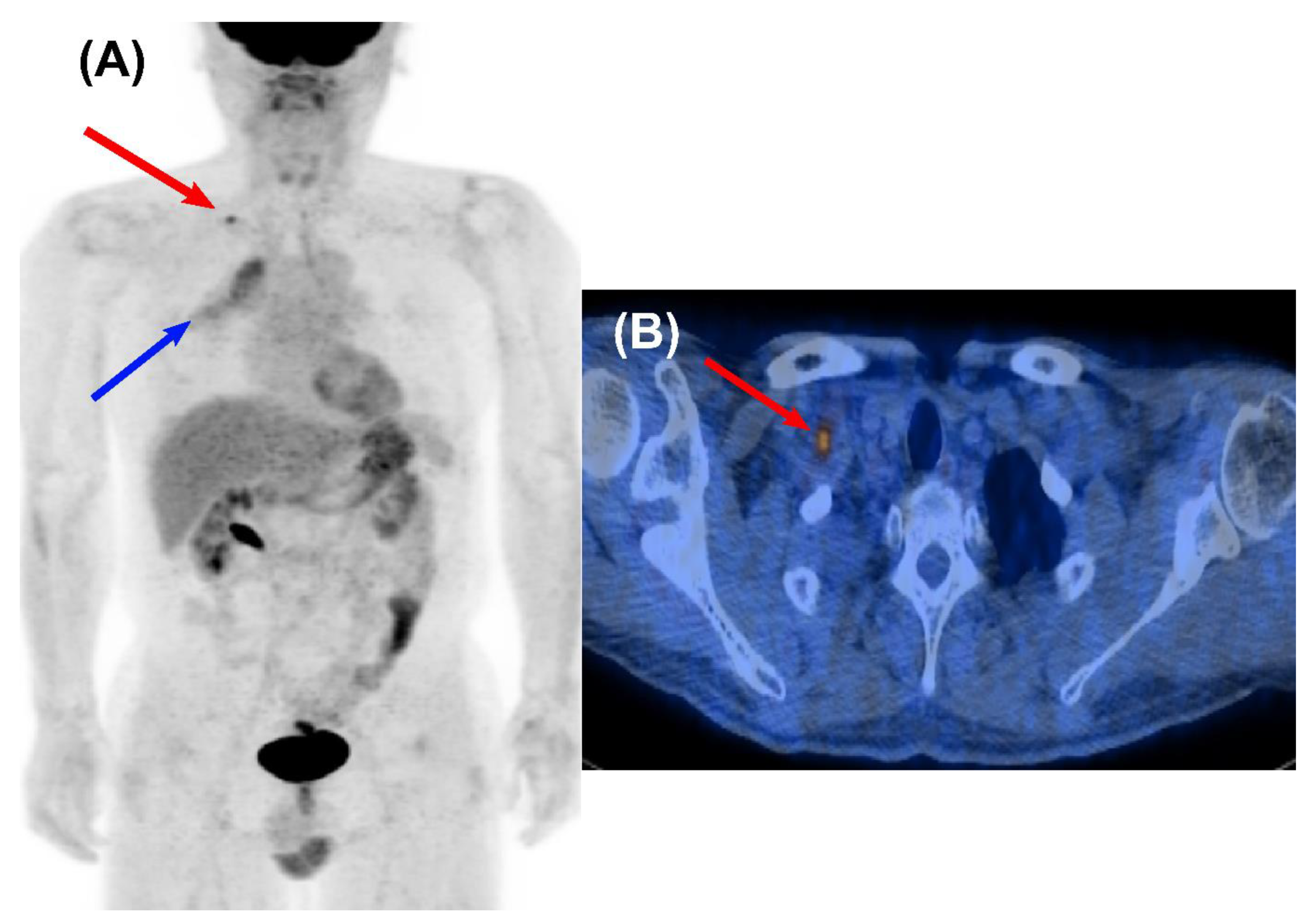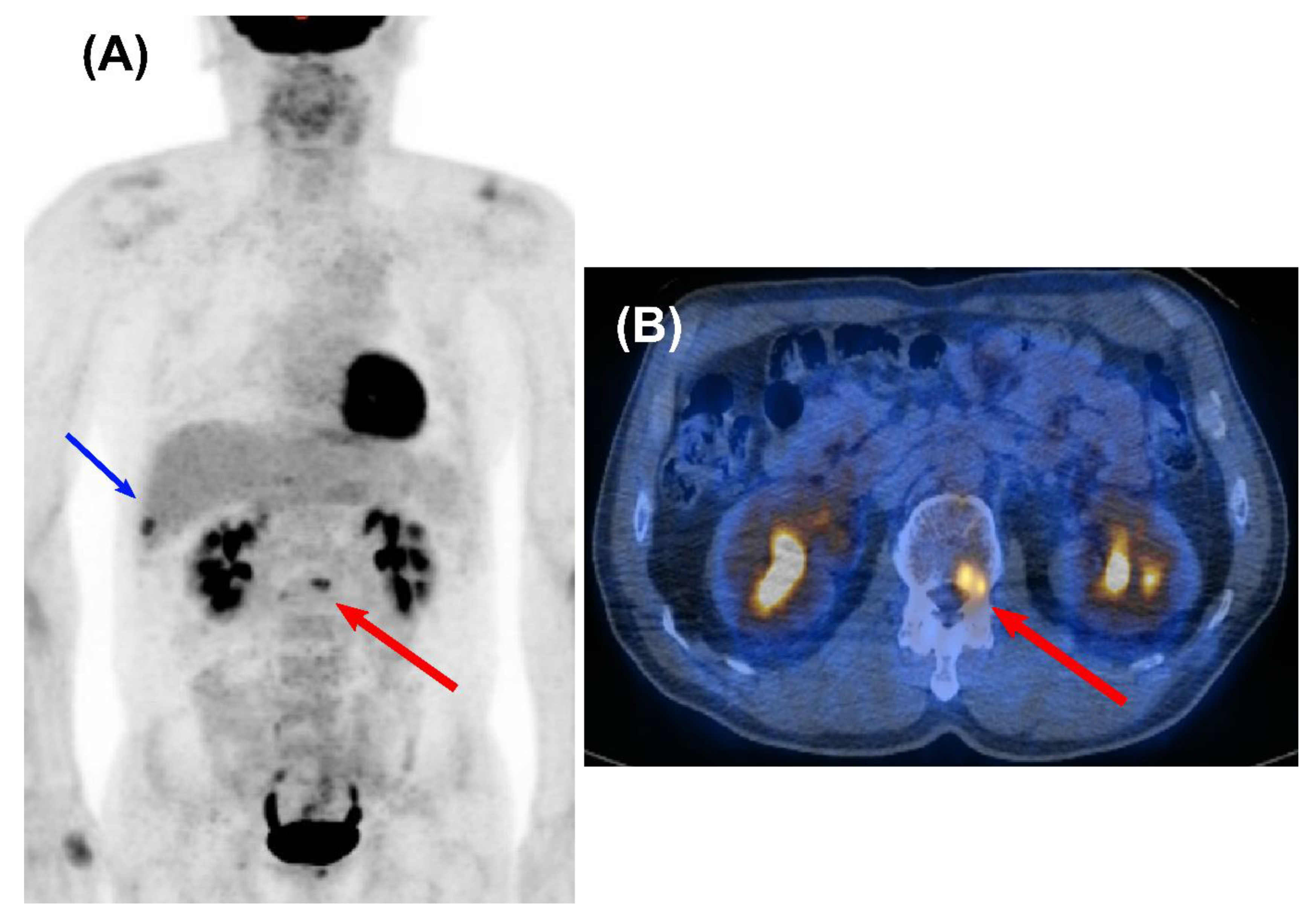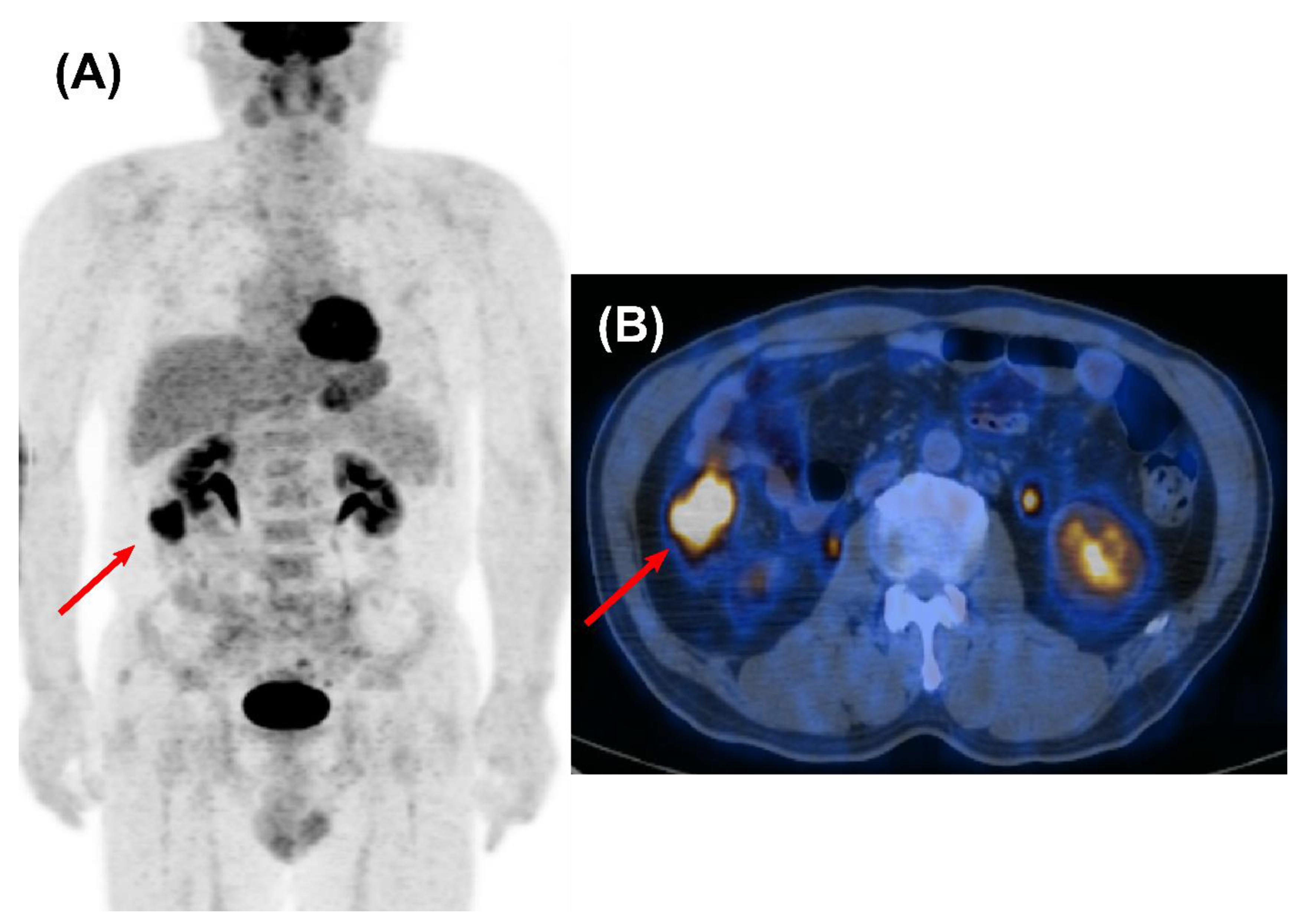Clinical Value of Surveillance 18F-fluorodeoxyglucose PET/CT for Detecting Unsuspected Recurrence or Second Primary Cancer in Non-Small Cell Lung Cancer after Curative Therapy
Abstract
Simple Summary
Abstract
1. Introduction
2. Materials and Methods
2.1. Subject Identification
2.2. FDG PET/CT Protocol
2.3. FDG PET/CT Imaging Report Review
2.4. Medical Record Review and Clinical Decision
2.5. Follow-Up Scheme
2.6. Statistical Analysis
3. Results
3.1. Characteristics of the Study Subjects
3.2. Diagnostic Performance of Surveillance FDG PET/CT for Detection of Relapse
3.3. Comparison of Diagnostic Capability of Surveillance FDG PET/CT According to Clinical Setting
3.4. Diagnostic Performance of Surveillance FDG PET/CT according to Initial Stage and Timing of PET/CT Scan after Curative-Intent Therapy
3.5. The Extent of First Recurrence Detected by True-Positive Surveillance PET/CT Results
3.6. Imaging Characteristics of False-Positive and False-Negative Surveillance PET/CT Results
3.7. Detection of Clinically Unsuspected Second Primary Cancer
4. Discussion
5. Conclusions
Author Contributions
Funding
Institutional Review Board Statement
Informed Consent Statement
Data Availability Statement
Conflicts of Interest
References
- Sung, H.; Ferlay, J.; Siegel, R.L.; Laversanne, M.; Soerjomataram, I.; Jemal, A.; Bray, F. Global Cancer Statistics 2020: GLOBOCAN Estimates of Incidence and Mortality Worldwide for 36 Cancers in 185 Countries. CA Cancer J. Clin. 2021, 71, 209–249. [Google Scholar] [CrossRef] [PubMed]
- Duma, N.; Santana-Davila, R.; Molina, J.R. Non-Small Cell Lung Cancer: Epidemiology, Screening, Diagnosis, and Treatment. Mayo Clin. Proc. 2019, 94, 1623–1640. [Google Scholar] [CrossRef] [PubMed]
- Endo, C.; Sakurada, A.; Notsuda, H.; Noda, M.; Hoshikawa, Y.; Okada, Y.; Kondo, T. Results of long-term follow-up of patients with completely resected non-small cell lung cancer. Ann. Thorac. Surg. 2012, 93, 1061–1068. [Google Scholar] [CrossRef] [PubMed]
- Kay, F.U.; Kandathil, A.; Batra, K.; Saboo, S.S.; Abbara, S.; Rajiah, P. Revisions to the Tumor, Node, Metastasis staging of lung cancer (8th edition): Rationale, radiologic findings and clinical implications. World J. Radiol. 2017, 9, 269–279. [Google Scholar] [CrossRef]
- Gomez, D.R.; Tang, C.; Zhang, J.; Blumenschein, G.R., Jr.; Hernandez, M.; Lee, J.J.; Ye, R.; Palma, D.A.; Louie, A.V.; Camidge, D.R.; et al. Local Consolidative Therapy Vs. Maintenance Therapy or Observation for Patients with Oligometastatic Non-Small-Cell Lung Cancer: Long-Term Results of a Multi-Institutional, Phase II, Randomized Study. J. Clin. Oncol. 2019, 37, 1558–1565. [Google Scholar] [CrossRef]
- Palma, D.A.; Olson, R.; Harrow, S.; Gaede, S.; Louie, A.V.; Haasbeek, C.; Mulroy, L.; Lock, M.; Rodrigues, G.B.; Yaremko, B.P.; et al. Stereotactic ablative radiotherapy versus standard of care palliative treatment in patients with oligometastatic cancers (SABR-COMET): A randomised, phase 2, open-label trial. Lancet 2019, 393, 2051–2058. [Google Scholar] [CrossRef]
- Pieterman, R.M.; van Putten, J.W.; Meuzelaar, J.J.; Mooyaart, E.L.; Vaalburg, W.; Koëter, G.H.; Fidler, V.; Pruim, J.; Groen, H.J. Preoperative staging of non-small-cell lung cancer with positron-emission tomography. N. Engl. J. Med. 2000, 343, 254–261. [Google Scholar] [CrossRef]
- Sawada, S.; Suehisa, H.; Ueno, T.; Sugimoto, R.; Yamashita, M. Monitoring and management of lung cancer patients following curative-intent treatment: Clinical utility of 2-deoxy-2-[fluorine-18]fluoro-d-glucose positron emission tomography/computed tomography. Lung Cancer 2016, 7, 45–51. [Google Scholar] [CrossRef][Green Version]
- Keidar, Z.; Haim, N.; Guralnik, L.; Wollner, M.; Bar-Shalom, R.; Ben-Nun, A.; Israel, O. PET/CT using 18F-FDG in suspected lung cancer recurrence: Diagnostic value and impact on patient management. J. Nucl. Med. 2004, 45, 1640–1646. [Google Scholar]
- Jiménez-Bonilla, J.F.; Quirce, R.; Martínez-Rodríguez, I.; Banzo, I.; Rubio-Vassallo, A.S.; Del Castillo-Matos, R.; Ortega-Nava, F.; Martínez-Amador, N.; Ibáñez-Bravo, S.; Carril, J.M. Diagnosis of recurrence and assessment of post-recurrence survival in patients with extracranial non-small cell lung cancer evaluated by 18F-FDG PET/CT. Lung Cancer 2013, 81, 71–76. [Google Scholar] [CrossRef]
- Stirling, R.G.; Chau, C.; Shareh, A.; Zalcberg, J.; Fischer, B.M. Effect of Follow-Up Surveillance After Curative-Intent Treatment of NSCLC on Detection of New and Recurrent Disease, Retreatment, and Survival: A Systematic Review and Meta-Analysis. J. Thorac. Oncol. 2021, 16, 784–797. [Google Scholar] [CrossRef] [PubMed]
- Rankin, S. PET/CT for staging and monitoring non small cell lung cancer. Cancer Imaging 2008, 8, S27–S31. [Google Scholar] [CrossRef] [PubMed][Green Version]
- Kanzaki, R.; Higashiyama, M.; Maeda, J.; Okami, J.; Hosoki, T.; Hasegawa, Y.; Takami, M.; Kodama, K. Clinical value of F18-fluorodeoxyglucose positron emission tomography-computed tomography in patients with non-small cell lung cancer after potentially curative surgery: Experience with 241 patients. Interact. Cardiovasc. Thorac. Surg. 2010, 10, 1009–1014. [Google Scholar] [CrossRef] [PubMed]
- Toba, H.; Sakiyama, S.; Otsuka, H.; Kawakami, Y.; Takizawa, H.; Kenzaki, K.; Kondo, K.; Tangoku, A. 18F-fluorodeoxyglucose positron emission tomography/computed tomography is useful in postoperative follow-up of asymptomatic non-small-cell lung cancer patients. Interact. Cardiovasc. Thorac. Surg. 2012, 15, 859–864. [Google Scholar] [CrossRef]
- Takenaka, D.; Ohno, Y.; Koyama, H.; Nogami, M.; Onishi, Y.; Matsumoto, K.; Matsumoto, S.; Yoshikawa, T.; Sugimura, K. Integrated FDG-PET/CT vs. standard radiological examinations: Comparison of capability for assessment of postoperative recurrence in non-small cell lung cancer patients. Eur. J. Radiol. 2010, 74, 458–464. [Google Scholar] [CrossRef]
- Kim, B.I. Radiological Justification for and Optimization of Nuclear Medicine Practices in Korea. J. Korean Med. Sci. 2016, 31 (Suppl. S1), S59–S68. [Google Scholar] [CrossRef]
- Shin, D.W.; Cho, J.H.; Yoo, J.E.; Cho, J.; Yoon, D.W.; Lee, G.; Shin, S.; Kim, H.K.; Choi, Y.S.; Kim, J.; et al. Conditional Survival of Surgically Treated Patients with Lung Cancer: A Comprehensive Analyses of Overall, Recurrence-free, and Relative Survival. Cancer Res. Treat. 2021, 53, 1057–1071. [Google Scholar] [CrossRef]
- He, Y.Q.; Gong, H.L.; Deng, Y.F.; Li, W.M. Diagnostic efficacy of PET and PET/CT for recurrent lung cancer: A meta-analysis. Acta Radiol. 2014, 55, 309–317. [Google Scholar] [CrossRef]
- Gambazzi, F.; Frey, L.D.; Bruehlmeier, M.; Janthur, W.D.; Graber, S.M.; Heuberger, J.; Springer, O.S.; Zweifel, R.; Boerner, B.; Tini, G.M.; et al. Comparing Two Imaging Methods for Follow-Up of Lung Cancer Treatment: A Randomized Pilot Study. Ann. Thorac. Surg. 2019, 107, 430–435. [Google Scholar] [CrossRef]
- Srikantharajah, D.; Ghuman, A.; Nagendran, M.; Maruthappu, M. Is computed tomography follow-up of patients after lobectomy for non-small cell lung cancer of benefit in terms of survival? Interact. Cardiovasc. Thorac. Surg. 2012, 15, 893–898. [Google Scholar] [CrossRef]
- Israel, O.; Kuten, A. Early detection of cancer recurrence: 18F-FDG PET/CT can make a difference in diagnosis and patient care. J. Nucl. Med. 2007, 48 (Suppl. S1), 28–35. [Google Scholar]
- Dziedzic, D.A.; Rudzinski, P.; Langfort, R.; Orlowski, T. Risk Factors for Local and Distant Recurrence after Surgical Treatment in Patients with Non-Small-Cell Lung Cancer. Clin. Lung Cancer 2016, 17, e157–e167. [Google Scholar] [CrossRef] [PubMed]
- Lou, F.; Sima, C.S.; Rusch, V.W.; Jones, D.R.; Huang, J. Differences in patterns of recurrence in early-stage versus locally advanced non-small cell lung cancer. Ann. Thorac. Surg. 2014, 98, 1755–1760. [Google Scholar] [CrossRef] [PubMed]
- Šimundić, A.M. Measures of Diagnostic Accuracy: Basic Definitions. Ejifcc 2009, 19, 203–211. [Google Scholar]
- Toba, H.; Kawakita, N.; Takashima, M.; Matsumoto, D.; Takizawa, H.; Otsuka, H.; Tangoku, A. Diagnosis of recurrence and follow-up using FDG-PET/CT for postoperative non-small-cell lung cancer patients. Gen. Thorac. Cardiovasc. Surg. 2021, 69, 311–317. [Google Scholar] [CrossRef]
- Davis, S.D.; Yankelevitz, D.F.; Henschke, C.I. Radiation effects on the lung: Clinical features, pathology, and imaging findings. AJR Am. J. Roentgenol. 1992, 159, 1157–1164. [Google Scholar] [CrossRef]
- Crestani, B.; Kambouchner, M.; Soler, P.; Crequit, J.; Brauner, M.; Battesti, J.P.; Valeyre, D. Migratory bronchiolitis obliterans organizing pneumonia after unilateral radiation therapy for breast carcinoma. Eur. Respir. J. 1995, 8, 318–321. [Google Scholar] [CrossRef]
- Liu, Y. Postoperative reactive lymphadenitis: A potential cause of false-positive FDG PET/CT. World J. Radiol. 2014, 6, 890–894. [Google Scholar] [CrossRef]
- Yorke, E.D.; Jackson, A.; Rosenzweig, K.E.; Merrick, S.A.; Gabrys, D.; Venkatraman, E.S.; Burman, C.M.; Leibel, S.A.; Ling, C.C. Dose-volume factors contributing to the incidence of radiation pneumonitis in non-small-cell lung cancer patients treated with three-dimensional conformal radiation therapy. Int. J. Radiat. Oncol. Biol. Phys. 2002, 54, 329–339. [Google Scholar] [CrossRef]
- Lim, C.H.; Ahn, T.R.; Moon, S.H.; Cho, Y.S.; Choi, J.Y.; Kim, B.T.; Lee, K.H. PET/CT features discriminate risk of metastasis among single-bone FDG lesions detected in newly diagnosed non-small-cell lung cancer patients. Eur. Radiol. 2019, 29, 1903–1911. [Google Scholar] [CrossRef]
- Treglia, G.; Sadeghi, R.; Annunziata, S.; Lococo, F.; Cafarotti, S.; Prior, J.O.; Bertagna, F.; Ceriani, L.; Giovanella, L. Diagnostic performance of fluorine-18-fluorodeoxyglucose positron emission tomography in the assessment of pleural abnormalities in cancer patients: A systematic review and a meta-analysis. Lung Cancer 2014, 83, 1–7. [Google Scholar] [CrossRef] [PubMed]
- Choi, S.H.; Kim, Y.T.; Kim, S.K.; Kang, K.W.; Goo, J.M.; Kang, C.H.; Kim, J.H. Positron emission tomography-computed tomography for postoperative surveillance in non-small cell lung cancer. Ann. Thorac. Surg. 2011, 92, 1826–1832. [Google Scholar] [CrossRef] [PubMed]
- Morbelli, S.; Conzi, R.; Campus, C.; Cittadini, G.; Bossert, I.; Massollo, M.; Fornarini, G.; Calamia, I.; Marini, C.; Fiz, F.; et al. Contrast-enhanced [18F] fluorodeoxyglucose-positron emission tomography/computed tomography in clinical oncology: Tumor-, site-, and question-based comparison with standard positron emission tomography/computed tomography. Cancer Imaging 2014, 14, 10. [Google Scholar] [CrossRef] [PubMed]
- Korst, R.J.; Gold, H.T.; Kent, M.S.; Port, J.L.; Lee, P.C.; Altorki, N.K. Surveillance computed tomography after complete resection for non-small cell lung cancer: Results and costs. J. Thorac. Cardiovasc. Surg. 2005, 129, 652–660. [Google Scholar] [CrossRef] [PubMed]
- Korst, R.J.; Kansler, A.L.; Port, J.L.; Lee, P.C.; Altorki, N.K. Accuracy of surveillance computed tomography in detecting recurrent or new primary lung cancer in patients with completely resected lung cancer. Ann. Thorac. Surg. 2006, 82, 1009–1015. [Google Scholar] [CrossRef]
- Wu, B.; Cui, Y.; Tian, J.; Song, X.; Hu, P.; Wei, S. Effect of second primary cancer on the prognosis of patients with non-small cell lung cancer. J. Thorac. Dis. 2019, 11, 573–582. [Google Scholar] [CrossRef]
- Bang, J.I.; Lee, E.S.; Kim, T.S.; Kim, S.K. Unexpected Second Primary Malignancies Detected by F-18 FDG PET/CT during Follow-up for Primary Malignancy: Two Case Reports. Nucl. Med. Mol. Imaging 2015, 49, 65–68. [Google Scholar] [CrossRef][Green Version]
- Choi, J.Y.; Lee, K.S.; Kwon, O.J.; Shim, Y.M.; Baek, C.H.; Park, K.; Lee, K.H.; Kim, B.T. Improved detection of second primary cancer using integrated [18F] fluorodeoxyglucose positron emission tomography and computed tomography for initial tumor staging. J. Clin. Oncol. 2005, 23, 7654–7659. [Google Scholar] [CrossRef]
- Lou, F.; Huang, J.; Sima, C.S.; Dycoco, J.; Rusch, V.; Bach, P.B. Patterns of recurrence and second primary lung cancer in early-stage lung cancer survivors followed with routine computed tomography surveillance. J. Thorac. Cardiovasc. Surg. 2013, 145, 75–81. [Google Scholar] [CrossRef]
- Choi, J.Y.; Lee, K.S.; Kim, H.J.; Shim, Y.M.; Kwon, O.J.; Park, K.; Baek, C.H.; Chung, J.H.; Lee, K.H.; Kim, B.T. Focal thyroid lesions incidentally identified by integrated 18F-FDG PET/CT: Clinical significance and improved characterization. J. Nucl. Med. 2006, 47, 609–615. [Google Scholar]
- Cho, S.K.; Choi, J.Y.; Yoo, J.; Cheon, M.; Lee, J.Y.; Hyun, S.H.; Lee, E.J.; Lee, K.H.; Kim, B.T. Incidental Focal (18)F-FDG Uptake in the Prostate: Clinical Significance and Differential Diagnostic Criteria. Nucl. Med. Mol. Imaging 2011, 45, 192–196. [Google Scholar] [CrossRef] [PubMed][Green Version]
- Hall, M.K.; Kea, B.; Wang, R. Recognising Bias in Studies of Diagnostic Tests Part 1: Patient Selection. Emerg. Med. J. 2019, 36, 431–434. [Google Scholar] [PubMed]
- Pinto, A.; Brunese, L. Spectrum of diagnostic errors in radiology. World J. Radiol. 2010, 2, 377–383. [Google Scholar] [CrossRef] [PubMed]
- Geijer, H.; Geijer, M. Added value of double reading in diagnostic radiology, a systematic review. Insights Imaging 2018, 9, 287–301. [Google Scholar] [CrossRef]
- van Loon, J.; Grutters, J.P.; Wanders, R.; Boersma, L.; Dingemans, A.M.; Bootsma, G.; Geraedts, W.; Pitz, C.; Simons, J.; Brans, B.; et al. 18FDG-PET-CT in the follow-up of non-small cell lung cancer patients after radical radiotherapy with or without chemotherapy: An economic evaluation. Eur. J. Cancer 2010, 46, 110–119. [Google Scholar] [CrossRef]



| Variable | Number (%) | |
|---|---|---|
| Age, years | Mean ± SD | 61.1 ± 9.8 |
| Sex | Male | 1914 (66.8%) |
| Location | Right lung | 1670 (58.3%) |
| Left lung | 1194 (41.6%) | |
| Histology | Adenocarcinoma | 1836 (64.1%) |
| Squamous cell carcinoma | 855 (29.9%) | |
| Other NSCLC | 173 (6.0%) | |
| T stage | T1 | 1324 (46.2%) |
| T2 | 1203 (42.0%) | |
| T3 | 243 (8.5%) | |
| T4 | 94 (3.3%) | |
| N stage | N0 | 1962 (68.5%) |
| N1 | 365 (12.7%) | |
| N2 | 484 (16.9%) | |
| N3 | 53 (1.9%) | |
| Stage | I | 1333 (46.5%) |
| II | 879 (30.7%) | |
| IIIA | 577 (20.2%) | |
| IIIB | 75 (2.6%) | |
| Curative treatment modality | Surgery | 2711 (94.7%) |
| Definitive CCRT | 77 (2.7%) | |
| Definitive RT | 76 (2.6%) | |
| Neoadjuvant treatment | No | 2618 (91.4%) |
| CCRT | 199 (7.0%) | |
| RT | 6 (0.2%) | |
| Chemotherapy | 44 (1.5%) | |
| Adjuvant treatment | No | 1802 (62.9%) |
| CCRT | 242 (8.5%) | |
| RT | 169 (5.9%) | |
| Chemotherapy | 648 (22.6%) | |
| Number of surveillance PET/CT | 1 | 1746 (61.0%) |
| scans for each patient | 2 | 730 (25.5%) |
| 3 | 294 (10.3%) | |
| 4 | 80 (2.8%) | |
| 5 | 14 (0.5%) |
| Parameter | Incidence of Recurrence | TP (N) | FP (N) | FN (N) | TN (N) | Sensitivity (%) | Specificity (%) | PPV (%) | NPV (%) | Accuracy (%) | |
|---|---|---|---|---|---|---|---|---|---|---|---|
| Overall | 6.2% (277/4478) | 274 | 79 | 3 | 4122 | 98.9 | 98.1 | 77.6 | 99.9 | 98.2 | |
| Initial stage (AJCC 7th) | I | 3.4% (70/2067) | 70 | 32 | 0 | 1965 | 100.0 | 98.4 | 68.6 | 100.0 | 98.5 |
| II | 5.8% (82/1427) | 80 | 27 | 2 | 1318 | 97.6 | 98.0 | 74.8 | 99.9 | 98.0 | |
| III | 12.7% (125/984) | 124 | 20 | 1 | 839 | 99.2 | 97.7 | 86.1 | 99.9 | 97.9 | |
| Time interval between curative therapy and PET/CT, months | <12 | 7.7% (130/1685) | 128 | 34 | 2 | 1521 | 98.5 | 97.8 | 79.0 | 99.9 | 97.9 |
| 12–36 | 6.5% (122/1893) | 121 | 26 | 1 | 1745 | 99.2 | 98.5 | 82.3 | 99.9 | 98.6 | |
| ≥36 | 2.8% (25/900) | 25 | 19 | 0 | 856 | 100.0 | 97.8 | 56.8 | 100.0 | 97.9 | |
| Curative treatment modality | Surgery | 6.1% (260/4258) | 257 | 65 | 3 | 3933 | 98.8 | 98.4 | 79.8 | 99.9 | 98.4 |
| RT ± CTx | 7.7% (17/220) | 17 | 14 | 0 | 189 | 100.0 | 93.1 | 54.8 | 100.0 | 93.6 |
| Parameter | Total (N) | TP (N) | FP (N) | FN (N) | TN (N) | Sensitivity (%) | Specificity (%) | PPV (%) | NPV (%) | Accuracy (%) |
|---|---|---|---|---|---|---|---|---|---|---|
| PET/CT scan < 36 with initial stage I–II | 2757 | 134 | 42 | 2 | 2579 | 98.5 | 98.4 | 76.1 | 99.9 | 98.4 |
| PET/CT scan < 36 with initial stage III | 821 | 115 | 18 | 1 | 687 | 99.1 | 97.5 | 86.5 | 99.9 | 97.7 |
| PET/CT scan ≥ 36 with initial stage I–II | 737 | 16 | 17 | 0 | 704 | 100.0 | 97.6 | 48.5 | 100.0 | 97.7 |
| PET/CT scan ≥ 36 with initial stage III | 163 | 9 | 2 | 0 | 152 | 100.0 | 98.7 | 81.8 | 100.0 | 98.8 |
Publisher’s Note: MDPI stays neutral with regard to jurisdictional claims in published maps and institutional affiliations. |
© 2022 by the authors. Licensee MDPI, Basel, Switzerland. This article is an open access article distributed under the terms and conditions of the Creative Commons Attribution (CC BY) license (https://creativecommons.org/licenses/by/4.0/).
Share and Cite
Lim, C.H.; Park, S.B.; Kim, H.K.; Choi, Y.S.; Kim, J.; Ahn, Y.C.; Ahn, M.-j.; Choi, J.Y. Clinical Value of Surveillance 18F-fluorodeoxyglucose PET/CT for Detecting Unsuspected Recurrence or Second Primary Cancer in Non-Small Cell Lung Cancer after Curative Therapy. Cancers 2022, 14, 632. https://doi.org/10.3390/cancers14030632
Lim CH, Park SB, Kim HK, Choi YS, Kim J, Ahn YC, Ahn M-j, Choi JY. Clinical Value of Surveillance 18F-fluorodeoxyglucose PET/CT for Detecting Unsuspected Recurrence or Second Primary Cancer in Non-Small Cell Lung Cancer after Curative Therapy. Cancers. 2022; 14(3):632. https://doi.org/10.3390/cancers14030632
Chicago/Turabian StyleLim, Chae Hong, Soo Bin Park, Hong Kwan Kim, Yong Soo Choi, Jhingook Kim, Yong Chan Ahn, Myung-ju Ahn, and Joon Young Choi. 2022. "Clinical Value of Surveillance 18F-fluorodeoxyglucose PET/CT for Detecting Unsuspected Recurrence or Second Primary Cancer in Non-Small Cell Lung Cancer after Curative Therapy" Cancers 14, no. 3: 632. https://doi.org/10.3390/cancers14030632
APA StyleLim, C. H., Park, S. B., Kim, H. K., Choi, Y. S., Kim, J., Ahn, Y. C., Ahn, M.-j., & Choi, J. Y. (2022). Clinical Value of Surveillance 18F-fluorodeoxyglucose PET/CT for Detecting Unsuspected Recurrence or Second Primary Cancer in Non-Small Cell Lung Cancer after Curative Therapy. Cancers, 14(3), 632. https://doi.org/10.3390/cancers14030632






